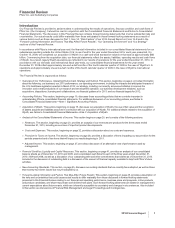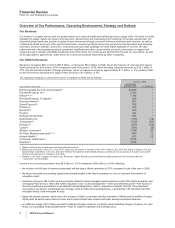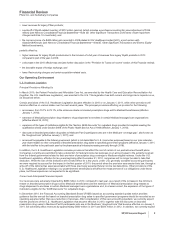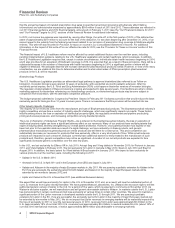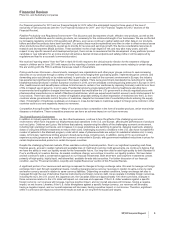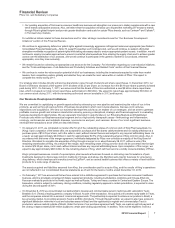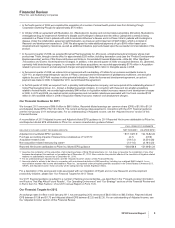Pfizer 2010 Annual Report Download - page 12
Download and view the complete annual report
Please find page 12 of the 2010 Pfizer annual report below. You can navigate through the pages in the report by either clicking on the pages listed below, or by using the keyword search tool below to find specific information within the annual report.
Financial Review
Pfizer Inc. and Subsidiary Companies
A reconciliation of 2012 Adjusted income and Adjusted diluted EPS targets to 2012 Reported Net income attributable to Pfizer Inc.
and Reported diluted EPS attributable to Pfizer Inc. common shareholders targets follows:
FULL-YEAR 2012 TARGETS
(BILLIONS OF DOLLARS, EXCEPT PER SHARE AMOUNTS) NET INCOME(a),(b) DILUTED EPS(a), (b)
Adjusted income/diluted EPS(c) targets ~$17.2-$17.9 ~$2.25-$2.35
Purchase accounting impacts of transactions completed as of 12/31/10 (3.8) (0.50)
Acquisition-related costs (0.7-1.0) (0.09-0.12)
Non-acquisition-related restructuring costs(d) (0.3-0.4) (0.03-0.05)
Reported Net income attributable to Pfizer Inc./diluted EPS targets ~$12.0-$13.1 ~$1.58-$1.73
(a) Assumes the completion of the acquisition of all remaining shares of King Pharmaceuticals, Inc., but does not assume the completion of any other
business-development transactions not completed as of December 31, 2010. Also excludes the potential effects of the resolution of litigation-related
matters not substantially resolved as of December 31, 2010.
(b) Given the longer-term nature of these targets, they are subject to greater variability and less certainty as a result of potential material impacts
related to foreign exchange fluctuations, macroeconomic activity including inflation, and industry-specific challenges including changes to govern-
ment healthcare policy, among others.
(c) For an understanding of Adjusted income, see the “Adjusted Income” section of this Financial Review.
(d) Amounts relate to actions to be taken in connection with our planned reduction in R&D spending, including our realigned R&D footprint. In our
reconciliation between Net income attributable to Pfizer Inc., as reported under U.S. GAAP, and Adjusted income, these amounts will be catego-
rized as Certain Significant Items.
We expect to generate cost reductions associated with the Wyeth acquisition, net of investments in the business, of approximately
$4 billion to $5 billion, by the end of 2012, at 2008 average foreign exchange rates, in comparison with the 2008 pro forma combined
adjusted total costs of the legacy Pfizer and legacy Wyeth operations. (For an understanding of Adjusted income, see the “Adjusted
Income” section of this Financial Review.) We achieved more than $2 billion of these cost savings in 2010. For a description of the
associated costs, expected to range from $2.0 billion to $4.0 billion during 2011 and 2012, see the “Costs and Expenses—Cost-
Reduction and Productivity Initiatives and Related Costs” section of this Financial Review.
In addition, we expect to generate significant reductions in our annual research and development expenses by the end of 2012.
Specifically, we expect adjusted R&D expenses to be approximately $8.0 billion to $8.5 billion in 2011 and approximately $6.5 billion
to $7.0 billion in 2012 (for an understanding of Adjusted income, see the “Adjusted Income” section of this Financial Review). For a
description of the associated costs, expected to range from $2.2 billion to $2.9 billion during 2011 and 2012, see the “Costs and
Expenses—Cost-Reduction and Productivity Initiatives and Related Costs” section of this Financial Review.
For further information on our research and development strategy, see also the “Our Strategy” section this Financial Review.
Our 2012 financial targets are subject to a number of factors and uncertainties—as described in the “Forward-Looking Information
and Factors That May Affect Future Results”, “Our Operating Environment” and “Our Strategy” sections of this Financial Review and
in Part I, Item 1A, “Risk Factors”, of our 2010 Annual Report on Form 10-K.
Accounting Policies
We consider the following accounting policies important in understanding our operating results and financial condition. For additional
accounting policies, see Notes to Consolidated Financial Statements––Note 1. Significant Accounting Policies.
Estimates and Assumptions
In preparing the consolidated financial statements, we use certain estimates and assumptions that affect reported amounts and
disclosures, including amounts recorded in connection with acquisitions, such as our acquisition of Wyeth on October 15, 2009.
These estimates and underlying assumptions can impact all elements of our financial statements. For example, in the consolidated
statements of income, estimates are used when accounting for deductions from revenues (such as rebates, chargebacks, sales
returns and sales allowances), determining cost of sales, allocating cost in the form of depreciation and amortization, and estimating
restructuring charges and the impact of contingencies. On the consolidated balance sheets, estimates are used in determining the
valuation and recoverability of assets, such as accounts receivable, investments, inventories, fixed assets and intangible assets
(including goodwill), and estimates are used in determining the reported amounts of liabilities, such as taxes payable, benefit
obligations, the impact of contingencies, rebates, chargebacks, sales returns and sales allowances, and restructuring reserves, all of
which also will impact the consolidated statements of income.
We regularly evaluate our estimates and assumptions, using historical experience and other factors, including the economic
environment. Our estimates often are based on complex judgments, probabilities and assumptions that we believe to be reasonable
but that are inherently uncertain and, in some cases, unpredictable.
As future events and their effects cannot be determined with precision, our estimates and assumptions may prove to be incomplete
or inaccurate, or unanticipated events and circumstances may occur that might cause us to change those estimates and
assumptions. Market conditions, such as illiquid credit markets, volatile equity markets, dramatic fluctuations in foreign currency
rates and economic downturns, can increase the uncertainty already inherent in our estimates and assumptions. We adjust our
estimates and assumptions when facts and circumstances indicate the need for change. Those changes will generally be reflected
in our financial statements on a prospective basis unless they are required to be treated retrospectively under the relevant
accounting standard. Although we believe our estimates are reasonable and our assumptions supportable, it is possible that other
professionals, applying reasonable judgment to the same facts and circumstances, could develop and support a range of alternative
10 2010 Financial Report



